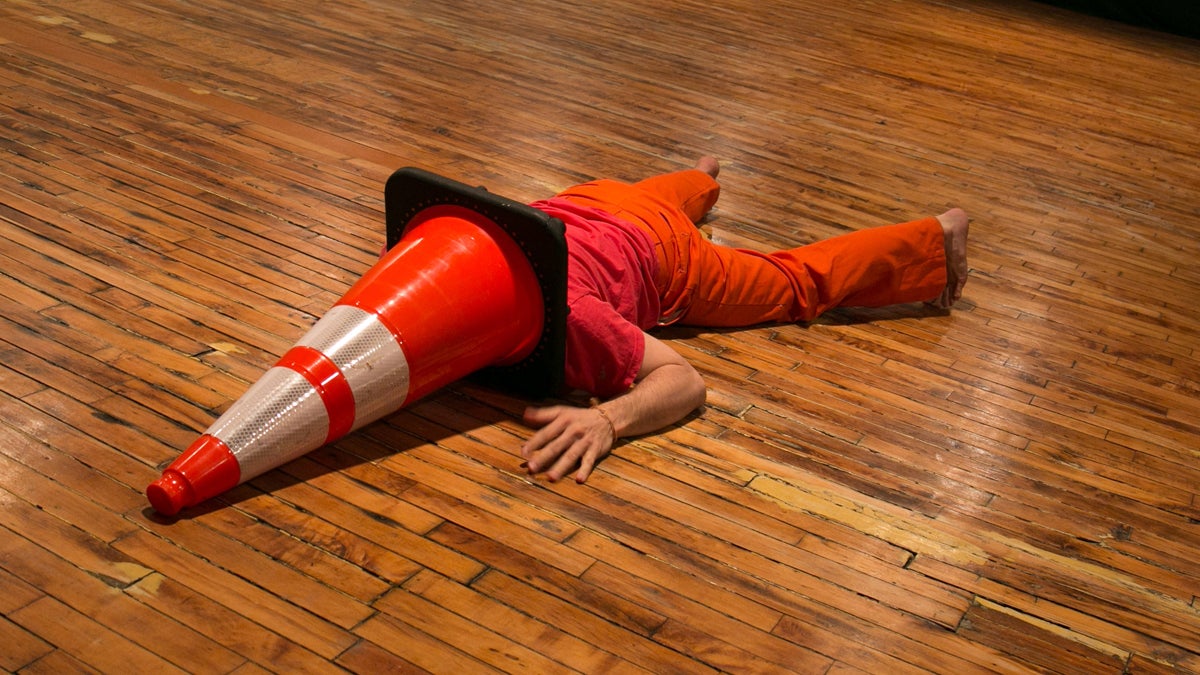Puppeteer is losing his sight, but not his creative vision
Listen
Morgan Andrews during a rehearsal for his performance "Cones." (Photo courtesy of Jenna Spitz)
A West Philly artists hopes to expose the sighted to the misunderstood world of the partially blind.
Morgan FitzPatrick Andrews is a West Philadelphia performance artist who stages interactive, intentionally homespun theatrical productions in unusual spaces, such as people’s bedrooms. He’s done this kind of work for 15 years, but until now, he has never used theater to address a topic that has inspired much of his other work as an artist.
Andrews has a rare congenital eye condition called Cone Rod Dystrophy. CRD is a deterioration of the cones, which are located in the center of the retina at the Fovea Centralis and are responsible for our central and color vision.
“It is a dominantly inherited condition, so half the people on my father’s side have this disease,” explained Andrews.
Cones, which was directed by Mason Rosenthal, another theater artist with an ocular condition, is a one-man show about vampires, vision loss, and ice cream.
“I’ve never made a piece about my vision, yet it affects absolutely everything that I do. It’s really quite scary for me to just out myself like this. I wanted to make a piece that was about living somewhere in the space between blindness and sightedness. For someone like me with a retinal disease, I wanted to challenge the expectations of what seeing and blindness are supposed to be,” explained Andrews.
Andrews was given glasses at the age of four, after teachers noticed he held textbooks extremely close to his face.
“My glasses didn’t help at all because it’s not a question of focal length, which is what the lenses will correct, but it’s the reception of that image on the retina. I’m fairly certain that the glasses I was given were just arbitrary prescriptions.”
Before he was properly diagnosed, Andrews thought of his sight in superhero terms—”like I could see atoms”—and likened his visual experience of the world to the static of an old cathode ray tube television.
His artistic output across music, visual art, and performance initially became a direct extension of his experiences with CRD. “The reality is that my vision is deteriorating in this certain way, and part of the process of making art is to see what can emerge in its place.”
He first gravitated toward music.
“It was like, ‘Well, I’m losing my vision. I guess I’ll be the blind guy on the porch playing the guitar.’ Then, I took a different turn and decided that what I wanted to do was rehabilitate my vision. So, I became a graphic artist working a lot with woodblock prints. I liked that a lot because with the woodcuts, it was more like I was pulling these images out of the darkness. Then I got really into shadow puppetry, because I wanted to use this process of carving things out of blackness to tell stories.”
In his early teens, an ophthalmologist finally diagnosed Morgan with CRD after running tests for Macular degeneration, a retinal condition common in adults over 50.
“The doctors were very excited, because it’s a super rare disease and they had a whole family of people that they could now study.”
The CRD5 diagnosis, however, did not magically clarify Andrews’ perception of himself or what it means to live with visual impairment.
“We are all somewhere on the spectrum between sighted and blind, and that changes from any given moment. Like, if you are out in the sun and then you suddenly come into a dark space and there are all these spots in front of your eyes, you can’t see. For some of us, those moments of being temporarily disabled are longer or more frequent. But there’s this in-between space that so many people fall into with low vision.”
One of Andrews’ major goals with his show Cones is to inspire more nuanced conversation about blindness and disability.
“There are lots of media representations of people who are fully blind. You can think of Oedipus or King Lear when the guy gets his eyes gouged out, superheroes like Daredevil or “Tommy” by The Who—it’s all or nothing. But there are very few media representations of people that are partially blind or losing their vision.”
What about Mr. Magoo, the classic 1950s cartoon about a lovable retiree whose near-sightedness causes him to constantly mistake one thing for another?
“There’s a lot of truth to it, but I hate Mr. Magoo! It’s just so stupid. It’s so bad. Mr. Magoo is a one-note joke, and I want to make the conversation so much more nuanced.”
Andrews hopes that Cones might shed light on the cones we encounter in different facets of our lives—”ice cream cones, pine cones”—including cones that those of us with more refined vision may not even notice.
“In making Cones, the road cone has become this icon for me in making this work. There are road cones everywhere! There will be a cone sitting on some pothole for years; everyone notices the pothole, but they don’t necessarily notice the cone. So, there are all these things that I can’t see, but then there are all sorts of things that I notice that the normally sighted 20/20 person who doesn’t have an eye disease can’t see.”
Cones premieres Friday, June 19th at the Rotunda as part of the SoLow Festival.
WHYY is your source for fact-based, in-depth journalism and information. As a nonprofit organization, we rely on financial support from readers like you. Please give today.



